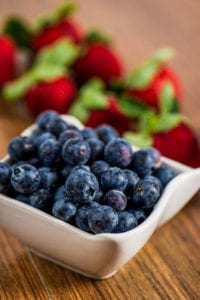MAKING THE SEASON BRIGHT Over 70 members of the Centerport Garden Club gathered at the Harborfields Public Library in Greenlawn before the holidays to make Christmas wreaths for the community. Handmade with evergreens from the members’ gardens, the completed wreaths adorned the local post office, library, town memorials and historic homes. Members also created holiday centerpieces for donation to local veteran’s homes.

Long Island Museum receives generous gift

The Long Island Museum in Stony Brook recently announced that its collections committee voted to approve the acquisition of an original oil painting by artist Jane Wilson, who passed away early in 2015. The painting, titled “Storm Light,” was completed in 1993 and is a gift of Wilson’s estate.
The LIM’s Director of Collections and Interpretation Joshua Ruff commented, “We are very happy to be one of a number of institutions that were chosen by Jane Wilson’s Estate to receive her work.” “Storm Light” is the fifth example of Wilson’s work to be added to The Long Island Museum’s permanent collection. The museum owns four additional Wilson paintings dating from 1955 to 2000. Other institutions that own her work include the Hirshhorn Museum, the Modern Museum of Art, the Smithsonian, and the Parrish Art Museum.
Jane Wilson, who was a part-time resident of eastern Long Island since 1960, was a talented painter who merged expressionism and realism, creating memorable landscapes known most for their dramatic horizons. After her passing early last year, she was the focus (along with fellow artist Jane Freilicher) of a major exhibition at the Parrish Art Museum. “Storm Light” will be highlighted as a new acquisition, on prominent display, when The LIM opens its new season on Feb. 24.
 WINTER HOURS FOR THE LIM: The Visitors Center of the The Long Island Museum, 1200 Route 25A, Stony Brook will be open from Jan. 5 to 29 from Thursday to Saturday from 10 a.m. to 5 p.m. and Sundays from noon to 5 p.m.; closed from Jan. 30 to Feb. 1. The Carriage Museum will be open from Feb. 2 to 18, Thursday to Sunday from noon to 5 p.m. and again on Feb. 23 from 11 a.m. to 5 p.m. The Art Museum is closed through Feb. 1. For further information, please call 631-751-0066 or visit www.longislandmuseum.org.
WINTER HOURS FOR THE LIM: The Visitors Center of the The Long Island Museum, 1200 Route 25A, Stony Brook will be open from Jan. 5 to 29 from Thursday to Saturday from 10 a.m. to 5 p.m. and Sundays from noon to 5 p.m.; closed from Jan. 30 to Feb. 1. The Carriage Museum will be open from Feb. 2 to 18, Thursday to Sunday from noon to 5 p.m. and again on Feb. 23 from 11 a.m. to 5 p.m. The Art Museum is closed through Feb. 1. For further information, please call 631-751-0066 or visit www.longislandmuseum.org.
Gardening: Where do those odd plant names come from?
By Ellen Barcel
Sometimes we just plunge into gardening and sometimes, especially if it snows outside, we’re staring at a beautiful fire in the fireplace and just pondering where do those odd plant names come from?
Marshmallow

Ever wonder where the word “marshmallow” comes from for the delightful candy we float in hot chocolate? Well, way back when, when the treat was first concocted in ancient Egypt, it was a mixture of honey (a sweetener) and the sap of the marshmallow plant (a thickener). Read the ingredients of marshmallows today and you’ll see they say basically sugar (the sweetener), water and gelatin (a thickener), then coated with cornstarch (to keep them from sticking together).
Marshmallow (Althaea officinalis) is a perennial plant found in Europe, Asia and North Africa and, as its name implies, grows in marshes. If you are interested in growing herbs, you can get the seeds online. The plant, which produces a light pink flower, grows to about three feet tall and needs a rich soil that holds moisture (remember it’s a marsh plant). It’s a perennial in U.S.D.A. zones 3 through 9 (Long Island is zone 7). You must be patient with this one as it doesn’t flower generally until the second year and may take even longer to have its roots large enough to harvest some.
Hellebores
Hellebores (Helleborus niger and H. orientalis) are early, herbaceous bloomers that come in a wide variety of colors from white through pinks and purples and even green. The cup-shaped flowers bend over (making it hard to photograph them, I know). Consider planting them in a raised bed so you can more easily enjoy the flowers.

Hellebores, also known as winter rose or Lenten rose, are not closely related to roses at all. They do well in U.S.D.A. hardiness zones 5 through 8. They’re very cold hardy — you can sometimes see them poking through late snows. However, check the variety you are planning to add to your garden as some are more cold tolerant than others.
But, where does the name hellebore come from? There’s folklore stating that the plant was used in old witchcraft to summon demons. But the name actually comes from the Greek meaning to harm food, as some varieties of hellebores are highly toxic, so I guess that is “hellish.” Other folklore, which relates to the name Christmas rose (H. niger), is that the tears of a young girl led the plant to bloom around Christmas as a gift to the Christ child.
Jacob’s ladder
Then there’s Jacob’s ladder (Polemonium caeruleum). The leaves rise along the stem, some seeing it like the biblical Jacob’s ladder to heaven in his dreams. According to Rutgers Extension, the plant is rarely bothered by deer, a plus on Long Island, but no plant is deer proof if they are hungry enough. It’s also somewhat drought tolerant, another plus, and shade tolerant. The bell-shaped flowers can be white, pink, blue or even yellow — take your pick.

Like hostas, Jacob’s ladder prefers a semi-shady to shady location since it is a small woodland plant. It can burn in strong sunlight. Make sure the soil is rich as a woodland’s might be. It prefers cooler weather and may need to be cut back in the heat of summer. P. reptans is a creeping Jacob’s ladder and native to North America.
I’ve read that cats really like Jacob’s ladder, as they like catnip, so if you have a lot of stray cats around you may need some form of protection for them, the plants that is, not the cats. An herbaceous perennial, it can be divided every few years. This is one where the seeds can still be planted in late autumn and will germinate the following spring.
Solomon’s seal
Solomon’s seal, (Polyonatum odoratum) also known as King Solomon’s seal is native to North America, does well in full or part shade and blooms May to June. The herbaceous perennial is in the asparagus family and a relative of lily of the valley.

As a woodland plant, it is relatively small, just a foot or two in height. In woodlands trees shed their leaves, which decay to form a rich compost, so keep this in mind when growing it in Long Island’s very sandy soil. Add compost to your shade planting bed (or let your leaves compost themselves under your trees in the shade). It does well in U.S.D.A. zones 5 through 9 and can be grown in more acidic soil than the others above, with a pH of 5.0 to 7.
Its scientific name refers to the “many knees” found on the underground rhizome. But where does the common name come from? Some noted the depressed spots on the underground roots and thought it looked like the royal king’s seal. Others thought a cross section of the stem resembled a Hebrew character.
Consider interspersing your Solomon’s seals with some nice, hardy ferns. Since they spread by the rhizomes as well as reseed themselves, you can develop a really nice bed. As they are somewhat slow growers, the seedlings will take a few years to bloom, but established beds can be divided in early spring.
The first three of the above plants do best in a soil pH near neutral (7) — only slightly acidic to a bit alkaline. Consider liming your soil if it is very acidic.
Ellen Barcel is a freelance writer and master gardener. To reach Cornell Cooperative Extension and its Master Gardener program, call 631-727-7850.
Cooking Cove: Dress up your bread pudding
By Barbara Beltrami
If ever there was a culinary invention that deserved the prize for simplicity, nutrition, versatility, economy and popularity, it’s got to be bread pudding. Take some leftover stale bread, throw in a couple of eggs, some milk, a little sugar and butter and vanilla and you basically have the foundation for not only a delicious dessert but a pretty wholesome breakfast! Dress it up by adding raisins, nuts, chocolate chips, chopped dried fruit, cinnamon or whatever your imagination dictates. For a quick and elegant dessert, top it with a stewed fruit compote, whipped cream, ice cream, vanilla, chocolate or whiskey sauce, liqueur or just about any combination. For breakfast, crank up the nutrition with that same stewed fruit compote, fresh fruit, yogurt, maple syrup, warm milk or a little dollop of jam. Again, the possibilities and combinations are practically endless, but my very favorites are the stewed fruit compote or just fresh fruit and whipped cream for dessert … or breakfast.
Basic Bread Pudding
YIELD: 4 to 6 servings
INGREDIENTS:
2 tablespoons butter, melted plus 1 tablespoon solid butter for greasing baking dish
2 cups milk
Dash of vanilla extract
½ cup sugar
Pinch of salt
3 eggs
5 to 6 cups day-old bread, cubed
DIRECTIONS: In a medium bowl, combine the melted butter, milk, vanilla, sugar, salt and eggs. Beat until well blended. Grease a 6- to 8-cup baking dish with the one tablespoon solid butter. Place the bread in the baking dish and pour liquid mixture over it. Cover, refrigerate and let sit until bread has soaked up all or most of the liquid. Preheat oven to 350 F. Uncover baking dish and bake 30 to 45 minutes until liquid is set and bread is golden. Serve warm or at room temperature. Refrigerate and reheat any unused portion.
Stewed Fruit Compote
INGREDIENTS:
4 cups fruit, pitted, pared, cored, as applicable
½ to 1 cup sugar, depending on sweetness of fruit
Dash of vanilla extract
One cinnamon stick
Peel of half an orange or lemon, pith removed
Red or white wine or apple juice to barely cover
DIRECTIONS: Combine all ingredients in non-reactive sauce pan. Cover and simmer over low heat until fruit is soft and liquid is somewhat reduced. Remove cinnamon stick and citrus peel. Let cool. Refrigerate, covered, until ready to use. Reheat and serve hot or warm over bread pudding. Top with whipped cream if desired.
Legally Speaking: Can a will’s executor take the money and run?
By Linda Toga
 THE FACTS: My father died recently. He had a will in which he named my brother as executor. My brother and I have not spoken to each other in a number of years. I am concerned that he will close out my father’s accounts and sell his house and keep all the money even though I am named as a half beneficiary under the will. He seems to be under the impression that since he is the named executor, he can do these things simply by presenting the will.
THE FACTS: My father died recently. He had a will in which he named my brother as executor. My brother and I have not spoken to each other in a number of years. I am concerned that he will close out my father’s accounts and sell his house and keep all the money even though I am named as a half beneficiary under the will. He seems to be under the impression that since he is the named executor, he can do these things simply by presenting the will.
QUESTION: Is that true?
THE ANSWER: Absolutely not! Although your brother is named in your father’s will as the executor of his estate, the surrogate’s court in the county in which your father resided at the time of his death must admit the will to probate and issue letters testamentary to your brother before he can take any action with respect to your father’s assets.
In other words, he must establish to the court’s satisfaction that the will is valid before he is able to act as executor. He cannot assume the responsibilities of executor without the court’s explicit approval. The complexity, cost and time involved in having a will admitted to probate will vary with the number of beneficiaries named in the will, as well as the number of heirs to the estate, the ease with which the attorney assisting the named executor can locate the beneficiaries and heirs, how cooperative those people may be with the attorney in moving forward, the value of the estate and whether anyone contests the admission of the will to probate, among other factors.
While the probate process can be straightforward and relatively inexpensive, there are numerous issues that can arise in the probate process that are best handled by an experienced estate attorney. Some of the most common issues with probate are not being able to locate individuals who are entitled to notice and dealing with individuals who contest the validity of the will. Fortunately, the percentage of cases where a will is contested and ultimately not admitted to probate is small. However, if there are objections filed to the probate of a will, the probate process can drag on for quite some time, significantly increasing the expenses of the estate.
If you and your brother are the only beneficiaries named in the will and your father’s only children, and you do not have a basis for contesting the will, the probate process should be relatively straightforward. Once the court issues letters testamentary to your brother, he can sell the house and close your father’s bank accounts. However, he cannot simply keep the money for himself since he has a legal obligation to carry out the wishes set forth in your father’s will.
In your case, he would be required to distribute to you assets valued at half of the value of the estate after accounting for your father’s legitimate debts, funeral and estate administration expenses, commissions and estate taxes. If you suspect that he has not done so, you should demand that he account for all of the estate assets so you can see the value of the marshaled assets and the expenses incurred by the estate. If you are not satisfied with the accounting he provides, or have reason to believe that he breached his fiduciary duty to you as a beneficiary, you can ask that his letters testamentary be revoked.
Since this process can get quite involved, if it comes to that, you should seek the advice of an attorney with expertise in the areas of estate administration and litigation.
Linda M. Toga, Esq. provides legal services in the areas of estate planning, probate and estate administration, real estate, small business service and litigation from her East Setauket office.
Photo of the Week
HAPPY NEW YEAR Nature photographer Jay Gammill of East Setauket captured this image of a red-tailed hawk eyeing his backyard feeder and its visitors on New Year’s Day. The bird of prey, knicknamed Big Red, has been a party crasher in the backyard for the past month.
Life Lines: Magic, religion and science

By Elof Axel Carlson
In 1890 Sir James George Frazer (1854-1941) wrote “The Golden Bough.” Frazer was Scottish, educated in Glasgow and then in Cambridge studying classical literature (Greek and Roman). He studied mythology, comparative religion and anthropology. His book argues that magic gave rise to religion and religion to science.
Magic assumes there are supernatural powers that some people can invoke or possess as innate gifts. With magic, what seems impossible can be made possible, at least to the observers of magical acts. Most professional magicians deny that they possess such gifts, and Houdini spent considerable time duplicating the tricks and illusions other magicians (and charlatans) used to deceive the public.
Frazer surmises the earliest humans believed in magical acts and associated them into rituals and myths with a belief in gods, often family ancestors, mythic heroes who were founders of a tribe, clan or larger population and sky gods. He believed the idea of resurrection came from the seasonal observation that plants die, scatter seeds and in the spring a resurrection occurs. He calls this “the dying corn god.”
Religion largely replaced magic as the basis for interpreting how the world arose, how society should function and how we relate to our gods. Religion in turn led to science with mathematics replacing numerology, astronomy coming out from astrology and chemistry from alchemy. The pursuit of knowledge from pseudoscience led to a weeding out of the failed experiments and predictions and a respect for more empirical and reason-based studies of the material, living and psychological universe in which we live.
Contemporary historians and philosophers differ with Frazer and among themselves on the origins of science. Some use a Marxist interpretation that farmers and workers laid the groundwork for science by their practical approaches to cultivate nature. Some argue that science is actually a cultural consensus or construction that shifts to new consensus and constructions in response to political and cultural changes.
Most scientists reject these social views of science and favor a material universe that can be explored, interpreted and manipulated with tools, experimentation, reason and data replacing myth, ideology or the supernatural. At issue in these debates are the ways scientists see the universe and their efforts to understand it. Science sometimes overthrows prevailing beliefs seen as truths. More often, it modifies its findings and its implications, incorporating the old as a portion of the new.
Newton’s laws of motion and gravity were not negated by Einstein’s theories of relativity or space-time. They became a more limited application useful for studying Earth and its solar system. Science is limited in what it can predict. We do not know if there are few, many or an unending number of scientific laws that may emerge in the centuries and millennia to come.
Elof Axel Carlson is a distinguished teaching professor emeritus in the Department of Biochemistry and Cell Biology at Stony Brook University.
Have you seen Wookie?

HELP BRING WOOKIE HOME! In the late evening of Nov. 11, 2016 there was a house fire on Minto Court off of North Howell Avenue in Centereach. The family and the family’s dogs escaped the fire. However, one of the dogs, Wookie, went missing after escaping the fire.
Wookie is a 10-year-old female shih tzu, beige in color. She is spayed and microchipped. This family has two small boys who desperately want their family to be complete again. The area is near Nicolls Road and Middle Country Road around the powerlines. No tip is too small.
Please call April at 631-278-4932 or join the Facebook group Finding Wookie.
‘Carousel’ hits local theaters
In honor of the 60th anniversary of “Carousel,” Fathom Events and Twentieth Century Fox will bring the Rodgers & Hammerstein classic to select cinemas nationwide on Sunday, Jan. 8 and Wednesday, Jan. 11 at 2 p.m. and again at 7 p.m. Starring Gordon MacRae as Billy Bigelow and Shirley Jones as Julie Jordan, “Carousel” features one of the most impressive and emotionally moving of all Rodgers & Hammerstein scores, as well as stunning cinematography — the 1956 film was shot largely on location in coastal Maine. Its score includes such classics as “Soliloquy,” “What’s the Use of Wond’rin,” the rousing “June Is Busting Out All Over” and the haunting, inspiring “You’ll Never Walk Alone.” The screenings will also include an exclusive interview between Shirley Jones and the president of Rodgers & Hammerstein, Ted Chapin.
“‘Carousel’ has always been dear to me, a film that remains beautiful, challenging and inspiring,” said Jones. “It was 60 years ago that we immortalized Rodgers & Hammerstein’s gorgeous musical, but when I think back on the memories it feels like no time at all has passed. I hope both longtime fans and new audiences will find it just as fresh and just as wonderful as ever.” “Movie musicals become an entirely different experience when viewed on the big screen and shared with an audience,” Fathom Events Vice President of Studio Relations Tom Lucas said. “We are proud to be presenting one of the best and most unique musicals of the 1950s, showcasing a truly extraordinary achievement of American moviemaking.”
Participating movie theaters in our neck of the woods include Island 16 Cinema De Lux in Holtsville and Farmingdale Multiplex Cinemas. For more information, please visit www.fathomevents.com.
Medical Compass: Simple weight management techniques for the New Year
By David Dunaief, M.D.

When we think of losing weight, calories are usually the first thing that comes to mind. We know that the more calories we consume, the greater our risk of becoming overweight or obese and developing many chronic diseases, including top killers such as heart disease, diabetes and cancer. Despite this awareness, obesity and chronic diseases are on the rise according to the Centers for Disease Control and Prevention.
How can this be the case? I am usually focused on the quality of foods, rather than calories, and I will delve into this area as well, but we suffer from misconceptions and lack of awareness when it comes to calories. The minefield of calories needs to be placed in context. In this article, we will put calories into context, as they relate to exercise, and help to elucidate the effects of mindful and distracted eating. Let’s look at the studies.
Impact of energy expenditure
One of the most common misconceptions is that if we exercise, we can be more lax about what we are eating. But researchers in a recent study found that this was not the case (1). The results showed that when menu items were associated with exercise expenditures, consumers tended to make better choices and ultimately eat fewer calories. In other words, the amount of exercise needed to burn calories was paired on the menu with food options, resulting in a significant reduction in overall consumption.
The example that the authors gave was that of a four-ounce cheeseburger, which required that women walk with alacrity for two hours in order to burn off the calories. Those study participants who had menus and exercise expenditure data provided simultaneously, compared to those who did not have the exercise data, chose items that resulted in a reduction of approximately 140 calories, 763 versus 902 kcals.
Even more interestingly, study participants not only picked lower calorie items, but they ate less of those items. Although this was a small preliminary study, the results were quite impactful. The effect is that calories become a conscious decision rooted in context, rather than an abstract choice.
The importance of mindful eating
Most of us like to think we are multitaskers. However, when eating, multitasking may be a hazard. In a meta-analysis (a group of 24 studies), researchers found that when participants were distracted while eating, they consumed significantly more calories immediately during this time period, regardless of dietary constraints (2).
This distracted eating also had an impact on subsequent meals, increasing the amount of food eaten at a later time period, while attentive eating reduced calories eaten in subsequent meals by approximately 10 percent. Distracted eating resulted in greater than 25 percent more calories consumed for the day. When participants were cognizant of the amount of food they were consuming, and when they later summoned memories of their previous eating, there was a vast improvement in this process.
The authors concluded that reducing distracted eating may be a method to help in both weight loss and weight management, providing an approach that does not necessitate calorie counting. These results are encouraging, since calorie counting frustrates many who are watching their weight over the long term.
The perils of eating out
Most of us eat out at least once in a while. In many cultures, it is a way to socialize. However, as much as we would like to control what goes into our food, we lose that control when eating out. In a study that focused on children, the results showed that when they ate out, they consumed more calories, especially from fats and sugars (3).
Of the 9,000 teenagers involved in the study, between 24 and 42 percent had gone to a fast-food establishment and 7 to 18 percent had eaten in sit-down restaurants when asked about 24-hour recall of their diets on two separate occasions.
Researchers calculated that this resulted in increases of 310 calories and 267 calories from fast-food and sit-down restaurants, respectively. This is not to say we shouldn’t eat out or that children should not eat out, but that we should have more awareness of the impact of our food choices. For example, many municipalities now require calories be displayed in chain restaurants.
Quality of calories

It is important to be aware of the calories we are consuming, not only from the quantitative perspective but also from a perspective that includes the quality of those calories. In another study involving children, the results showed that those offered vegetables for snacks during the time that they were watching television needed significantly fewer calories to become satiated than when given potato chips (4). The authors commented that this was true for overweight and obese children as well, however, they were more likely to be offered unhealthy snacks, like potato chips.
In a study published in JAMA in June 2012, the authors state that we should not restrict one type of nutrient over another but rather focus on quality of nutrients consumed (5). In my practice, I find that when my patients follow a vegetable-rich, nutrient-dense diet, one of the wonderful “side effects” they experience is a reduction or complete suppression of food cravings. As far as mindless eating goes, I suggest if you are going to snack while working, watching TV or doing some other activity, then snack on a nutrient-dense, low-calorie food, such as carrots, blueberries or blackberries. If you don’t remember how many vegetables or berries that you ate, you can take heart in knowing it’s beneficial. It can also be helpful to keep a log of what you’ve eaten for the day, to increase your cognizance of distracted eating.
Therefore, rather than counting calories and becoming frustrated by the process, be aware of the impact of your food choices. Why not get the most benefit out of lifestyle modifications with the least amount of effort? Rather than having to exercise more to try to compensate, if you actively choose nutrient-dense, low-calorie foods, the goal of maintaining or losing weight, as well as preventing or potentially reversing chronic diseases, becomes attainable through a much less painful and laborious process.
References: (1) J Exp Biol. 2013; Abstract 367.2. (2) Am J Clin Nutr. 2013 April;97:728-742. (3) JAMA Pediatr. 2013;167:14-20. (4) Pediatrics. 2013;131:22-29. (5) JAMA 2012; 307:2627-2634.
Dr. Dunaief is a speaker, author and local lifestyle medicine physician focusing on the integration of medicine, nutrition, fitness and stress management. For further information, visit www.medicalcompassmd.com or consult your personal physician.












